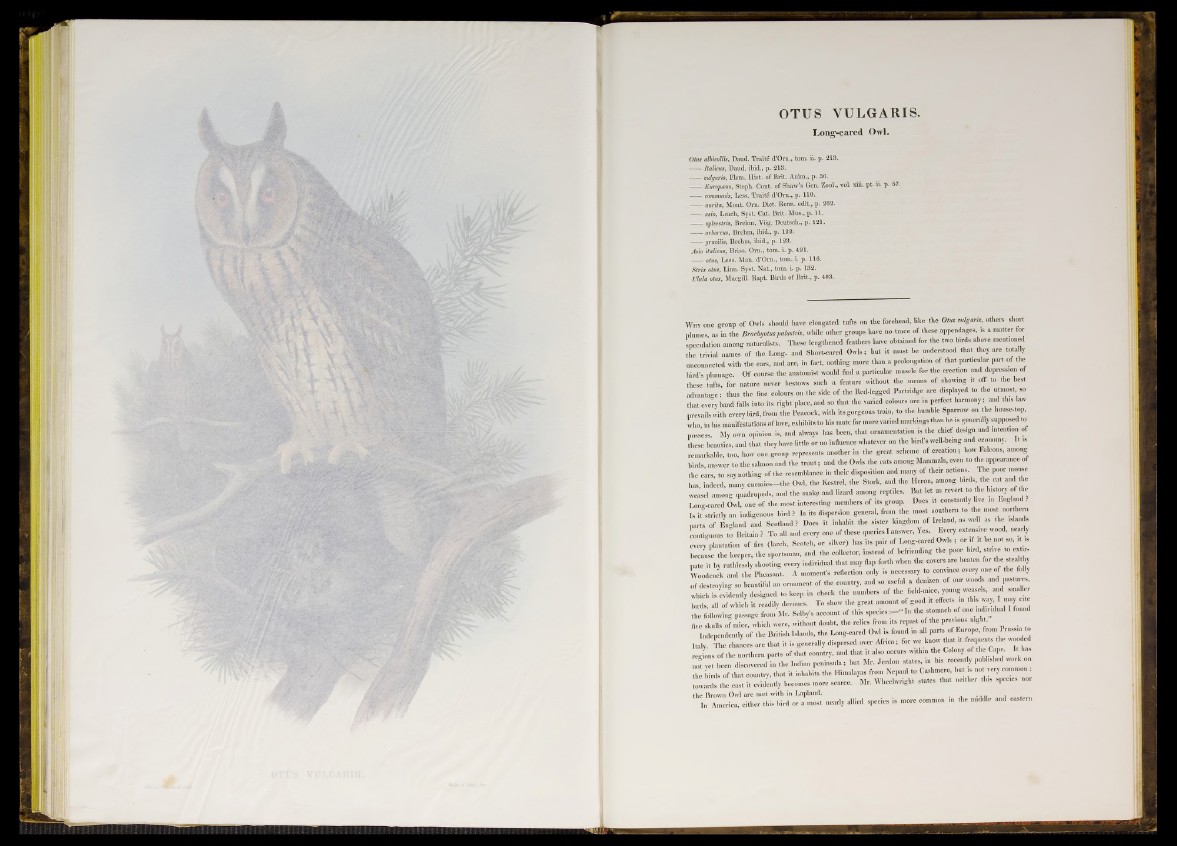
i l
«TUS VULGARIS.
Long-eared Owl.
Otus albicollis, Daud. Traité d’Orn., tom. ii. p. 213.
ÿ l— Italiens, Daud. ibid., p. 213.
vulgaris, Flem. Hist, of Brit. Anim., p. 56.
jEuropéens, Steph. Cont. of Shaw’s Gen. Zool., vol. xiii. pt. ii. p. 57.
communis, Less. Traité d’Orn., p. 110.
—— aurita, Mont. Orn. Diet. Renn, edit., p. 262.
asio, Leach, Syst. Cat. Brit. Mus., p. 11.
sylvestris, Brehm, Vög. Deutsch., p. 121.
- -— arbor eus, Brehm, ibid., p. 122.
gracilis, Brehm, ibid., p. 123.
Asio italicus, Briss. Orn., tom. i. p. 491.
otus, Less. Man. d’Orn., tom. i. p. 116.
Strix otus, Linn. Syst. Nat., tom. i. p. 132.
Ulula otus, Macgill. Rapt. Birds of Brit., p. 403.
Why one group of Owls should have elongated tufts on the forehead, like the Otus vulgaris, others short
plumes as in the Brachyotus p a lm tm , while other groups have no trace o f these appendages, is a matter for
speculation among naturalists. These lengthened feathers have obtained for the two birds above mentioned
the trivial names of the Long- and Short-eared Owls; but it must be understood that they are totally
unconnected with the ears, and are, in fact, nothing more than a prolongation of that particular p art of the
bird’s plumage. O f course the anatomist would find a particular muscle for the erection and depression of
these tufts for nature never bestows such a feature without the means of showing it off to the best
advantage: thus the fine colours on the side of the Bed-legged Partridge are displayed to the utmost so
that every hand falls into its right place, and so that the varied colours are in perfect harmony; and this law
prevails with every bird, from the Peacock, with its gorgeous train, to the humble Sparrow on the house-top,
who, in his manifestations oflove, exhibits to his mate for more varied m arkings than he ia generally supposed to
possess. My own opinion is, and always has been, th at ornamentation is the chief design and intention of
these beauties, and that they have little or no influence whatever on the bird’s well-being and economy. I t is
remarkable, too, how one group represents another in the great scheme o f creation; how Falcons, among
birds answer to the salmon and the tro u t; and the Owls the cats among Mammals, even to the appearance of
the ears, to say nothing o f the resemblance in their disposition and many o f their actions The poor mouse
has, indeed, many e n em ie s -th e Owl, the Kestrel, the Stork, and the Heron, among birds the eat and he
weasel among quadrupeds, and the snakp and lizard among reptiles. But let ns revert to the history of the
Lone-eared Owl, one of the most interesting members of its group. Does it constantly live in England .
Is it strictly an indigenous b ird ? Is its dispersion general, from the most southern to the most northern
parts of England and Scotland? Does it inhabit the sister kingdom o f Ireland, as well as the islands
contiguous to Britain? To aft and every one o f th e s e q u erie s I answer, Yes Every extensive wood, nearly
every plantation o f firs (larch, Scotch, or silver) has its pair of Long-eared Owls ; or if it be not so, it is
because the keeper, the sportsman, and the collector, instead of befriending the poor bird, strive to ex hr-
pate it by ruthlessly shooting every individual that may flap forth when the covers are beaten for the stealthy
Woodcock and the Pheasant. A moment's reflection only is necessary to convince every one of the folly
o f destroying so beautiful an ornament o f the country, and so useful a denizen of our woods and pastures,
w h i c h is evidently designed to keep in check the numbers of the field-mice, young weasels, and smaller
birds, all of which it readily devours. To show the great amount of good it effects in this way I may c
the following passage from Mr. Selby’s account of this s p e c i e s I n the stomach of one individual I found
five skulls of mice, which were, without doubt, the relics from its repast of the previous night.
Independently of the British Islands, the Long-eared Owl is found in all parts o f Europe, from Prussia to
Italy ■ chances are th at it is generally dispersed over Africa; for we know that I frequente the wooded
regions of the northern parts o f that country, and that it also occurs within the Colony of the Cape. It has
not yet been discovered in the Indian peninsula; but Mr. Jerdon states, in his recently published work on
the birds o f that country, that it inhabits the Himalayas from Nepaul to Cashmere, b a t is not very common :
towards the east it evidently becomes more scarce. M , Wheelwright states that neither this spee.es nor
the Brown Owl are met with in Lapland.
In America, either this bird or a most nearly allied species is more common in the middle and eastern